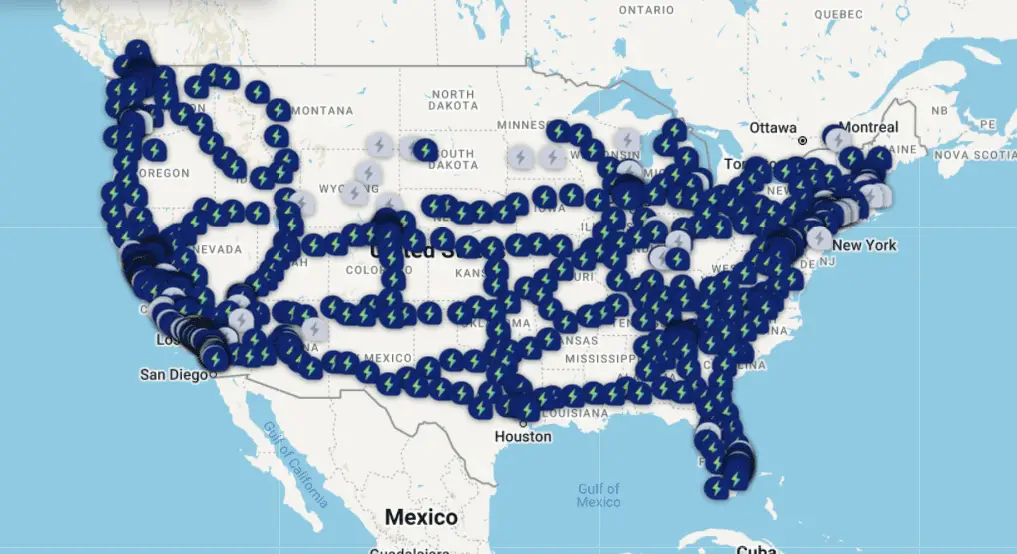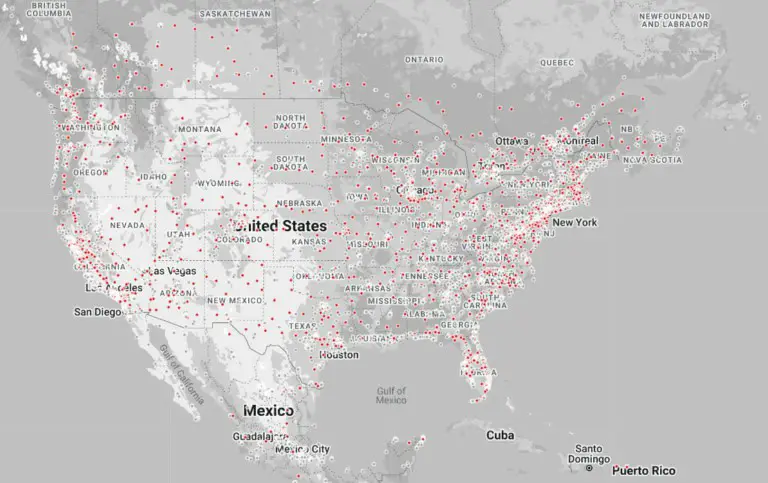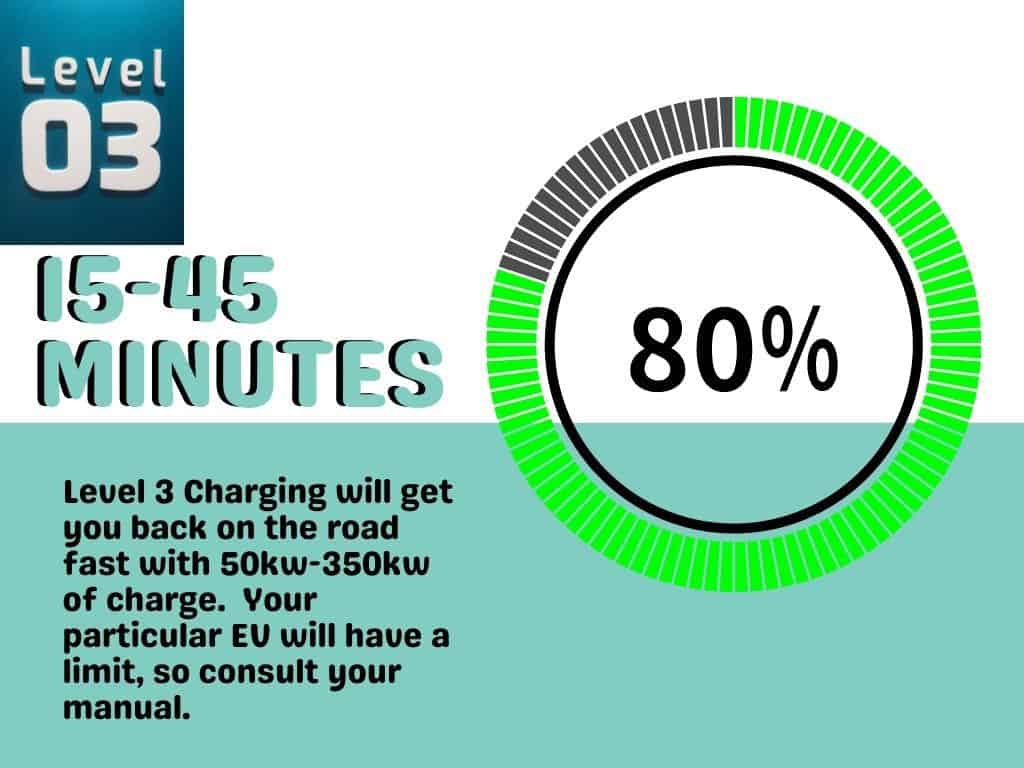A definite advantage of driving an electric vehicle is being able to combine the charging process with your shopping trip. Knocking out two birds with one stone, so to speak.
Target stores have been quickly expanding their charging stations, especially along major interstates.
If you’re newer to the concept of charging as you shop, you’re likely wondering just how long it will take to fill your electric battery back up.
Generally, you can expect to find free Level 2 charging stations at participating Target stores which will add 20 miles of driving distance per hour of charging. Tesla, Electrify America, and Chargepoint may also offer Level 3 fast charging by the minute or by the kilowatt-hour, depending on your state.
Below we’ll discuss where you can charge your vehicle at Target, how long it takes to charge an EV at Target, and the cost of charging an electric vehicle at Target.

Can I Charge an EV at Target?
Target, as a brand, does incorporate charging stations at many, but not all of its stores — yet.
Over the last several years, Target has partnered with Electrify America, Chargepoint, and Tesla to bring both Level 2 and Level 3 (the super fast type) charging options to more and more locations at a rapid rate.
To find the address of your Target of choice, you can check out their store directory here which is broken down by state and then by city. You can use the address found in the directory to see if that store is using Electrify America, Tesla, or Chargepoint in the maps down below.
I have to admit that it would be fantastic if Target just included whether or not they offer EV charging under the “services offered” when you click on “store info” in the directory.
Unfortunately, they make us do our own sleuthing by investigating each address in the following 3 interactive maps.
If you look at Electrify America’s website, you will see all of their charging locations. At the time of this article, there were 720 completed and 106 underway. Not all of these are at Target locations, and many of the stations are located at competitors of Target as well.

If you zoom in on the map at the right level, you’ll notice a pattern that the stations are all located along the most major of interstates and highways. So, if you’ve got a rural Target, you’re probably going to be waiting a little while.
Chargepoint has thousands of locations posted on their interactive map (see below). Of course, these are not all Target locations but you can easily search by location by clicking the link in this paragraph or the map below. You’ll be able to find out if your location has charging, what type of charging it provides, and usually how much it costs.

Finally, there is Tesla with all of their Superchargers (red dots) and Destination Charging locations (gray dots). You can click the map below to open an interactive map where you can check out all of your particular shopping destinations.

How Long Does it Take to Charge An EV at Target?
The Target locations that I was able to locate advertised charging speeds in the Level 2 range, and typically at 6.6kW per hour.
Essentially, that will only add on about 20 miles of driving distance per hour of charge.
So, in a one hour shopping trip you’ll gain 20 miles and you’ll gain 40 miles of driving distance in two hours of shopping.
Admittedly, it’s not that impressive, but every mile gained counts for something. Since most round trip commutes are going to be 20-40 miles, then the visit itself essentially covers the mileage.
What’s exciting for EV drivers is that Electrify America (one of Target’s partners) loves to install more and more Level 3 fast charging stations throughout the country.
If you’re lucky enough to find one at your particular Target, you’ll probably see them in the range of 150kW to 350kW. “kW” is short for kilowatts, or 1,000 watts.
Charging done at these speeds is done with Direct Current (DC) and not Alternating Current (AC), so it can bypass the onboard converter and charger in your EV and charge the battery directly. When using DC voltage, you are charging at Level 3 charging speeds. Sometimes this is referred to as “rapid charging” or “fast charging”.
On average, the typical range that you would gain per minute of rapid charging will be 8-20 mile, depending on the charging speed and the vehicle efficiency. Either way, most vehicles can charge from empty to 80% in 30 minutes or less.

Let’s take a look at the table below at some of the top 11 selling models in the USA and see what times you might expect if you were to charge at a Target charging station if you were to come across Level 3 Fast Charging Stations.
Keep in mind that even if a station offers 350kW, that does not mean that your car can accept it. In fact, at the time this article is being written, I believe the Porsche Taycan is the only EV to come close to that speed. In the table below you’ll see the maximum allowable current at Level 3 charging speeds.
Regardless, if the charging speed exceeds your vehicle’s max limit, then your vehicle will only receive up to its max. You can still use the charging station, you just won’t max it out.
| EV Model | Year | Net Battery Capacity (Usable) | Level 3 Charging Limit in Kilowatts | Charging at Target from 10% to 80% charge at 150kW (Minutes) | Charging at Target from 10% to 80% charge at 350kW (Minutes) |
|---|---|---|---|---|---|
| Tesla Model Y | 2022 | 75kW | 210 | 22 | 16 |
| Tesla Model 3 | 2022 | 82kW | 250 | 24 | 15 |
| Ford Mustang Mach E | 2022 | 91kW | 250 | 27 | 16 |
| Chevy Bolt EV | 2022 | 65kW | 55 | 52 | 52 |
| Volkswagen ID.4 | 2022 | 77kW | 135 | 25 | 25 |
| Nissan Leaf | 2022 | 62kW | 100 | 27 | 27 |
| Audi e-tron | 2022 | 91.5kW | 150 | 27 | 27 |
| Porsche Taycan | 2022 | 83.7kW | 270 | 25 | 14 |
| Tesla Model S | 2022 | 98kW | 250 | 29 | 17 |
| Hyundai Kona Electric | 2022 | 64kW | 75 | 38 | 38 |
| Tesla Model X | 2022 | 95kW | 250 | 28 | 17 |
When looking at this table, don’t think that just because a vehicle takes 20 minutes longer to charge that it is worse than one that takes 20 minutes less. Some EVs have ranges that far exceed others. If a vehicle takes 20 minutes longer to charge but you’ll receive 150 driving miles total beyond the one that takes less time, then that’s something to take into consideration.
Likewise, just because two vehicles have the same charging time does not mean that they are equal. One might have a bigger battery, longer range, and a faster max charging speed and charge the same as one with a smaller battery, shorter range, and a reduced max charging speed.
If you’re wondering how these numbers were calculated, you can check out my article here on Level 3 charging and you’ll be able to see the easy to use formulas so that you can calculate charging times and miles gained per minute of charging for any EV.
Is it Free to Charge an EV at Target (How Much Does it Cost)?
Generally, select Target stores offer free electric vehicle charging for up to 2 hours and charge a fee beyond that (typically $2 dollars per hour). The free charging offered is at Level 2 speeds and is generally around 7kW per hour. This will provide the typical EV with 20 miles of driving range per hour of charge time.
Since Target is partnered with at least 3 providers, the above statement is not a hard and fast rule, but generally the Level 2 charging (20 miles of range gained per hour) is complimentary for up to 2 hours. Level 3 charging is something that runs up the electric bill fast for the store and what you will be charged for that will depend on the provider that you find at that particular location.
The Electrify America charging stations typically charge by the minute or by the kilowatt-hour (kWh) depending on the state in which you live. Discounted prices are available to Electrify America Pass+ Members.
Twenty six states and DC charge by the kilowatt-hour, at a rate of about $0.43.
Twenty states charge by the minute. Either $0.16 per minute for 90kW speeds and below, or $0.32 per minute for speeds between 90kW and 350kW.
Electrify America Pass+ Members save 25% with a $4 per month subscription regardless of whether you pay by the kWh or the minute.
All states have an idle fee of $0.40 per minute after a 10 minute grace period to discourage drivers from parking long-term at the limited charging stations and stopping others from charging.
See the table below to see what to expect when charging your EV at Target in the USA for Level 3 Charging with Electrify America.
| Likely Payment Type and Cost at Target EV Charging Stations (Level 3) | States and District of Columbia (by Abbreviation) |
|---|---|
| Guests and Pass Members: 1-90kW: $0.16/minute 1-350kW: $0.32/minute Pass+ Members: 1-90kW: $0.12/Minute 1-350kW: $0.24/Minute | AL, GA, ID, IN, KS, KY, LA, MA, MS, MT, NE, NH, NM, OK, PA, SC, SD, TN, TX, WI |
| Guests and Pass Members: $0.43/kWh Pass+ Members: $0.31/kWh | AZ, AR, CA, CO, CT, DE, DC, FL, IL, IA, ME, MD, MI, MN, MO, NV, NJ, NY, NC, ND, OH, OR, RI, UT, VT, VA, WA |
If we look at a the Tesla Model X at the bottom of the table in the previous section, we can see that it takes 17 minutes to charge at the 350kW Target store charging station. If you were in a state that charged by the minute and you were not a Pass+ Member, you’d be charged $5.44 (17min x $0.32). If you charged that same vehicle in a state that charged by the kWh, you’d be charged $28.60 ((95kWh x 0.7) x $0.43)!
In the last calculation, we have a 95kWh battery that is already at 10% state of charge, and we are charging it to 80% (which is where a Level 3 Charger will cut off). Therefore, we only need to charge 70% of the 95kWh battery.
There seems to be a move by states to shift to charging per kWh in the name of fairness for the end user. This will take away any advantage an EV owner has who has a vehicle that has a very high max charging rate. The end result will be prices that will be more in line with gasoline prices for everyone involved.

